Navigation » List of Schools, Subjects, and Courses » Accounting 230 – Accounting Information Systems » Assessments » Chapter 5 Assessment
With Answers Good news! We are showing you only an excerpt of our suggested answer to this question. Should you need our help in customizing an answer to this question, feel free to send us an email at  or chat with our customer service representative.
or chat with our customer service representative.
Chapter 5 Assessment
Chapter 5 Assessment
1. Consider the following diagram. How will the database relationship between Employees and Sales Orders be implemented?
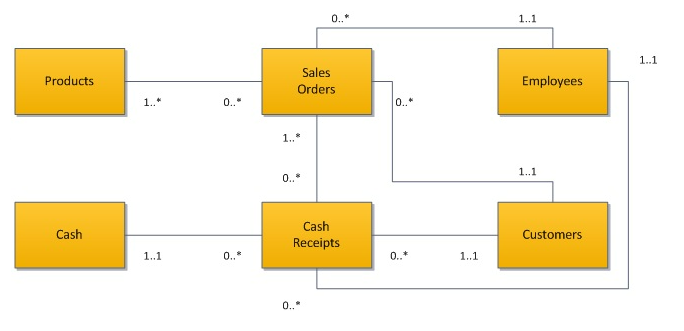
The Sales Order ID will be included as a primary key in the Employees table.
The Sales Order ID will be included as a foreign key in the Employees table.
The Employee ID will be included as a foreign key in the Sales Orders table.
The Employee ID will be included as a primary key in the Employees table.
2. Consider the following diagram. Which of the following best describes how the relationship between Sales Orders and Cash Receipts will be implemented in the resulting database?
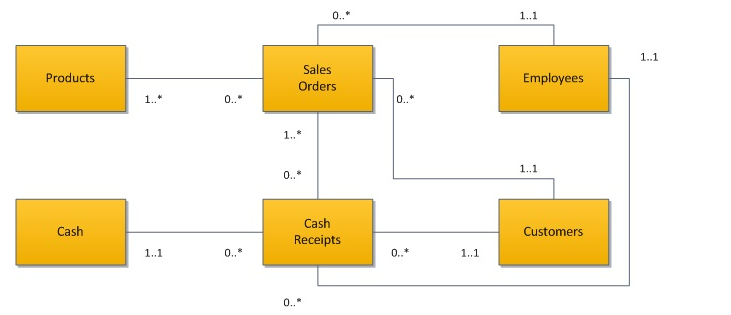
The Cash Receipt ID will be included as a foreign key in the Sales Orders table.
The Sales Order ID will be included as a foreign key in the Cash Receipts table.
The Cash Receipt Amount field will be included as a foreign key in the Cash Receipts table.
A new table will be created that contains both Sales Order ID and Cash Receipt ID as its composite primary key.
3. Which of the following accounts is generally not impacted as part of the Sales and Collections process?
Accounts PayableCorrect
Inventory
Cash
Accounts Receivable
4. Which of the following best describes the choreography in a BPMN activity diagram?
Hides activities that are not of interest in the analysis of the business process.
Shows the sequence of activities within one pool.
Follows the sequence flow from start to end.
Shows the interaction of messages between participants in the business process.
5.
Which of the following activities is not associated with the sales and collection business process?
Recording customer payments.
Billing customers.
Maintaining vendor records.
Selling products and services.
6. Business rules are an example of which COSO concept?
Control activities
Control environment
Activity models
Internal control
7. Which of the following best describes the purpose of an intermediate error event?
Depicts the sequence of activities in one pool.
Shows the interchange between two pools.
Contains a series of activities that are hidden from view.
Illustrates the process flow when an exception occurs.
8. Consider the following diagram. How will the database relationship between Customers and Sales Orders be implemented?
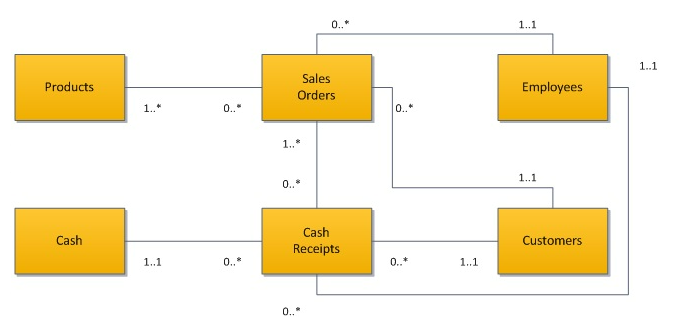
The Sales Order ID will be included as a foreign key in the Customers table.
The Sales Order ID will be included as a primary key in the Customer table.
The Customer ID will be included as a primary key in the Customer table.
The Customer ID will be included as a foreign key in the Sales Orders table.
9. Which of the following best describes the purpose of an intermediate timer event?
Determines when the business process begins.
Illustrates the process flow when a delay occurs.
Contains a series of activities that are hidden from view.
Shows the timing of messages between two pools.
10. Which of the following best describes the purpose of a BPMN collapsed sub-process?
A series of events is hidden from view as the information is not well controlled.
A series of events is hidden from view as the information is not necessary to the model.
The collapsed process contains too many errors.
The collapsed process will be modeled at a later time.
11. Which of the following best describes the orchestration in a BPMN activity diagram?
Shows the interaction of messages between participants in the business process.
Follows the sequence flow from start to end.
Shows the sequence of activities within one pool.
Hides activities that are not of interest in the analysis of the business process.
12. Which of the following is not an example of a business rule?
The credit department must approve all sales on account
Managers must approve orders over $10,000
Inventory must be maintained in a secure locationCorrect
Employee who receives checks can not change invoices
13. Which of the following best describes the difference between access controls and application controls?
There is no difference between access and application controls.
Access controls limit who can change records and application controls ensure data integrity and provide an audit trail of any changes.
Access controls limit how many records can be changed and application controls ensure segregation of duties.
Access controls are “prohibited” business rules and application controls are “allowed” business rules.
14. Consider the following diagram. Which of the following best describes how the relationship between Sales Orders and Products will be implemented in the resulting database?
The Quantity Ordered field will be included as a foreign key in the Products table.
A new table will be created that contains both Sales Order ID and Product ID as its composite primary key.
The Product ID will be included as a foreign key in the Sales Orders table.
The Sales Order ID will be included as a foreign key in the Products table.
15. Which of the following is not something a busines rule would implement?
Approval
Segregation of Duties
Authorization
Notifications
16 Consider the following diagram. Which answer provides the best interpretation of the multiplicities for the association between the Sales Orders class and the Cash Receipts class?
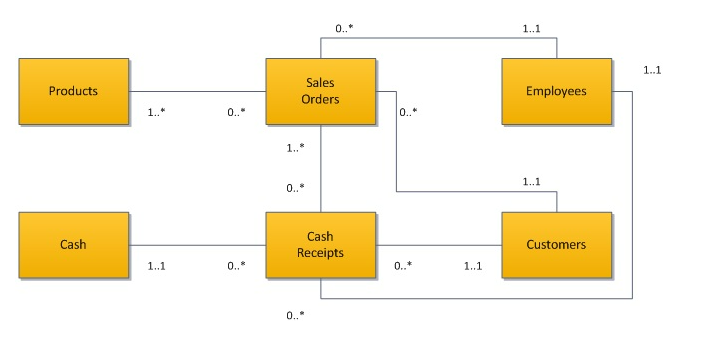
A single cash receipt may apply to only one sales order.
Customers may pay for sales orders in multiple payments.
An employee might never record a sales order.
Sales orders and cash receipts must be entered into the system at the same time.
17. Refer to the following diagram. Which of the following answers provides the best interpretation of the multiplicities for the association between the Cash Receipt and Cash classes?
Some cash receipts are not deposited into a bank account.
Each cash receipt is deposited into one bank account.
Each order increases accounts receivable.
The company only has one bank account.
18. What step should be taken when designing a relational database when a many-to-many relationships exists?
No action is needed.
Create two one-to-many relationships.Correct
Recreate the foreign key.
Create a boundary event.
19. Refer to the following diagram. Which of the following answers does not provide a valid interpretation of the multiplicities for the association between the Inventory and the Product Category classes?
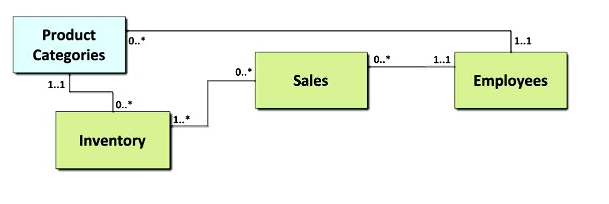
Some product categories do not include inventory items.
Every inventory item is in at most one product category.
Every product category is managed by one employee.
Every product category includes at least one inventory item.
20. Refer to the following diagram. Which of the following answers provides the best interpretation of the multiplicities for the association between the Order class and the Products class?
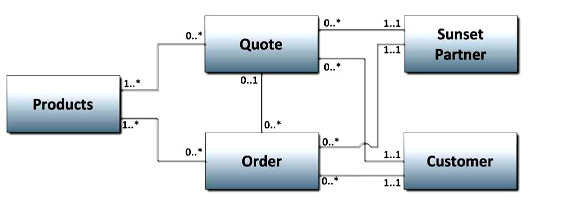
Each order must specify the same products as the previous quote.
An order may include many products.
Each product has been ordered at least once.
An order does not have to include a product.

